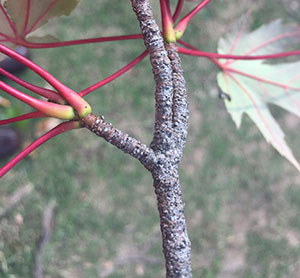Fall Landscaping
Fall Pest Control
Throughout the fall, continue picking off and destroying bagworm bags from evergreens, since each female bag contains 500–1,000 eggs, and hatching starts in May.
September
- Twig girdler insects should be controlled if large numbers of small branches of elms, pecans, or persimmons are uniformly girdled from the tree and fall to the ground. You can prevent the next generation by destroying the fallen twigs.
- Watch for spider mites in gardens. If plants appear to have lost their luster, you might have spider mites. View the underside of leaves with a hand lens. If you spot 1 or 2 per leaf, control can be achieved with a couple of applications of horticultural oil or insecticidal soap. Finding more than that, organic methods are found to be ineffective and you will need to use bifenthrin. If you experience spider mites every year, take a review of your gardening methods. Spider mites can be kept in check by applying good horticultural practices.
- Resume spraying roses that are susceptible to black spot and other fungus diseases when they have started a flush of fall growth.
October
- Apply glyphosate to perennial weeds like poison ivy and other problematic weeds. It’s this time of year when plants are transferring nutrients to the roots for winter dormancy. The success rate in controlling these weeds is very good when applied in the fall prior to dormancy.
- Both box elder and red-shouldered bugs are commonly seen in large masses on tree trunks and the siding of buildings at this time of year. They do little damage to trees but will feed on the seeds. Asian multicolored lady beetles may also be found this time of year. For us gardeners they are beneficial but a nuisance. Control out of doors for these three insects is not recommended, but you may find them objectionable when they migrate indoors. Insects found indoors can simply be vacuumed up and released outdoors.
- Webworms consume a tremendous amount of tree leaves. Because we are at the end of our growing season, loss of leaves is not going to hurt most trees. On trees, such as pecans and other fruit which have not fully developed yet, control may be warranted. If control is desired, chemical control measures include use of bifenthrin or Sevin. A natural product that may provide control is Bt (Bacillus thuringiensis). Spraying is most often not effective because the webbing prevents spray material from getting in contact with the worms.
Note: Webworms and bagworms are different pests. Webworms do not cause significant damage while bagworms can.
Visit our page on webworms and bagworms to learn the difference.
November

Red Maple with gloomy scale.
- Inspect crepe myrtles for a new insect invader, crape myrtle bark scale. Also, red maples are being attacked by gloomy scale.
- Use dormant oil sprays to control scale on ornamental plants, trees, and shrubs. Fruit trees will benefit from a dormant oil application each winter
Need additional help with pest control?
Ask our Pest Crew.
Have questions about plant damage?
Visit our page, Arkansas Plant Health Clinic.